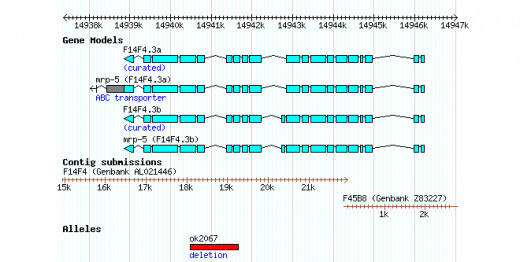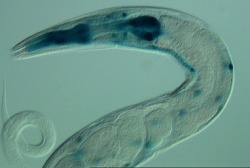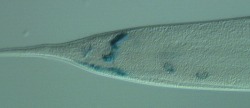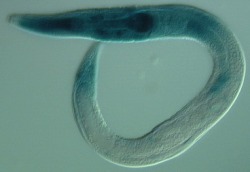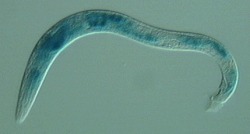This webpage was produced as an assignment for Genetics 677, an undergraduate course at the University of Wisconsin - Madison.
Homology with Eukaryotes
A homolog is a gene with shared characteristics evolved from a common ancestor. The CFTR gene has homologs in many eukaryotes, including the chimpanzee, dog, cow, mouse, rat, and zebrafish. Homologs were found at Homologene (1). Identities refers to the number of amino acids in the homolog that are identical to the human gene. Gaps refer to amino acids that are missing from the sequence.
Homologene
Pan troglodytes (Chimpanzee)
Name: Cystic Fibrosis Transmembrane Conductance Regulator
Abbreviation: CFTR
Gene accession number: NC_006474.2
Chromosome Location: 7
Protein accession number: XP_519330.2
Identities: 1475/1480 amino acids (99%)
Gaps: 0/1480 amino acids (0%)
Canis lupus familiaris (Dog)
Name: Cystic Fibrosis Transmembrane Conductance Regulator
Abbreviation: CFTR
Gene accession number: NC_006596.2
Chromosome Location: 14
Protein accession number: NP_001007144.1
Identities: 1336/1483 amino acids (90%)
Gaps: 3/1483 amino acids (0%)
Bos taurus (Cow)
Name: Cystic Fibrosis Transmembrane Conductance Regulator
Abbreviation: CFTR
Gene accession number: NC_007302.3
Chromosome Location: 4q23-q25
Protein accession number: NP_776443.1
Identities: 1333/1470 amino acids (90%)
Gaps: 3/1470 amino acids (0%)
Mus muscularis (Mouse)
Name: Cystic Fibrosis Transmembrane Conductance Regulator
Abbreviation: CFTR, Abcc7, AW495489
Gene accession number: NC_000072.5
Chromosome Location: 6 3.1cM (Mice have acrocentric chromosomes, so their chromosomal nomenclature is different)
Protein accession number: NP_066388.1
Identities: 1162/1481 amino acids (78%)
Gaps: 6/1481 amino acids (0%)
Rattus norvegicus (Rat)
Name: Cystic Fibrosis Transmembrane Conductance Regulator
Abbreviation: CFTR, RGD1561193
Gene accession number: NC_005103.2
Chromosome Location: 4q21
Protein accession number: XP_001062374.1
Identities: 1154/1481 amino acids (77%)
Gaps: 6/1481 amino acids (0%)
Danio rerio (Zebrafish)
Name: Cystic Fibrosis Transmembrane Conductance Regulator
Abbreviation: CFTR, si:dkey-27012.2
Gene accession number: NC_007129.3
Chromosome: 18
Protein accession number: NP_001038348.1
Identities: 833/1506 amino acids (55%)
Gaps: 47/1506 amino acids (3%)
Name: Cystic Fibrosis Transmembrane Conductance Regulator
Abbreviation: CFTR
Gene accession number: NC_006474.2
Chromosome Location: 7
Protein accession number: XP_519330.2
Identities: 1475/1480 amino acids (99%)
Gaps: 0/1480 amino acids (0%)
Canis lupus familiaris (Dog)
Name: Cystic Fibrosis Transmembrane Conductance Regulator
Abbreviation: CFTR
Gene accession number: NC_006596.2
Chromosome Location: 14
Protein accession number: NP_001007144.1
Identities: 1336/1483 amino acids (90%)
Gaps: 3/1483 amino acids (0%)
Bos taurus (Cow)
Name: Cystic Fibrosis Transmembrane Conductance Regulator
Abbreviation: CFTR
Gene accession number: NC_007302.3
Chromosome Location: 4q23-q25
Protein accession number: NP_776443.1
Identities: 1333/1470 amino acids (90%)
Gaps: 3/1470 amino acids (0%)
Mus muscularis (Mouse)
Name: Cystic Fibrosis Transmembrane Conductance Regulator
Abbreviation: CFTR, Abcc7, AW495489
Gene accession number: NC_000072.5
Chromosome Location: 6 3.1cM (Mice have acrocentric chromosomes, so their chromosomal nomenclature is different)
Protein accession number: NP_066388.1
Identities: 1162/1481 amino acids (78%)
Gaps: 6/1481 amino acids (0%)
Rattus norvegicus (Rat)
Name: Cystic Fibrosis Transmembrane Conductance Regulator
Abbreviation: CFTR, RGD1561193
Gene accession number: NC_005103.2
Chromosome Location: 4q21
Protein accession number: XP_001062374.1
Identities: 1154/1481 amino acids (77%)
Gaps: 6/1481 amino acids (0%)
Danio rerio (Zebrafish)
Name: Cystic Fibrosis Transmembrane Conductance Regulator
Abbreviation: CFTR, si:dkey-27012.2
Gene accession number: NC_007129.3
Chromosome: 18
Protein accession number: NP_001038348.1
Identities: 833/1506 amino acids (55%)
Gaps: 47/1506 amino acids (3%)
Wormbase
C. elegans has a copy of the mrp-5 gene, which encodes a homolog of the human gene CFTR. When the mrp-5 gene is mutated, it leads to cystic fibrosis.
Mrp-5 stands for: Multidrug resistance-associated protein/mitoxantrone resistance protein, ABC superfamily
Sequence Name: F14F4.3
Genetic Position: X:21.57 +/- 0.010 cM
Mrp-5 stands for: Multidrug resistance-associated protein/mitoxantrone resistance protein, ABC superfamily
Sequence Name: F14F4.3
Genetic Position: X:21.57 +/- 0.010 cM
Genomic Environs
Anatomic Expression Patterns
Expression is generally quite mosaic and occurs in all life stages. Expression occurs in most tissues including the pharynx, intestine, neurons, bodywall muscle, and hypodermis. Although due to mosaicism, any individual worm may only show a portion of expression.
Phenotypes observed via RNAi of mrp-5
1. Blistered: Fluid-filled blisters appear on the cuticle
2. Slow Growth: Any variation that causes a reduction in growth rate compared to control
3. Larval Lethal: The animal dies at any time between hatching and onset to adulthood
4. Sluggish: lethargic,slow compared with control animals
5. Clear: Animals appear unusually transparent when compared to control
6. Aldicarb Resistant: Animals fail to respond to the concentration of aldicarb that elicits a response in control animals. Alternatively, animals require increased concentration or longer exposure to this compound to elicit the response compared to control animals
2. Slow Growth: Any variation that causes a reduction in growth rate compared to control
3. Larval Lethal: The animal dies at any time between hatching and onset to adulthood
4. Sluggish: lethargic,slow compared with control animals
5. Clear: Animals appear unusually transparent when compared to control
6. Aldicarb Resistant: Animals fail to respond to the concentration of aldicarb that elicits a response in control animals. Alternatively, animals require increased concentration or longer exposure to this compound to elicit the response compared to control animals
Analysis
The homologue with the highest homology to the human CFTR gene is Pan troglodytes, the chimpanzee. This is logical, because among the listed homologes, the chimpanzee is most closely related to humans. The homologue with the lowest homology is Danio rerio, the zebrafish.
_______________
References
1. Homologene. Feb 21, 2010. http://www.ncbi.nlm.nih.gov/homologene
2. Wormbase. Feb 25, 2010. http://www.wormbase.org/
References
1. Homologene. Feb 21, 2010. http://www.ncbi.nlm.nih.gov/homologene
2. Wormbase. Feb 25, 2010. http://www.wormbase.org/
Alexandra Reynolds
[email protected]
